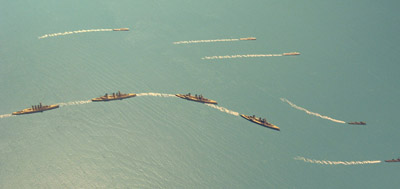Back in the day, great boardgames were hard to come by. It was the 80’s, and you pretty much either stuck to the slew of role playing games coming out, or tried your hand at wargaming. Sure there were some exceptions, but that’s how it rolled in my neck of the woods. I don’t remember who first introduced us to the Fletcher Pratt Naval War Game, perhaps Jeff does, but just thinking about it brings up the most exciting memories of battling on the high seas in WWII.
Fletcher Pratt was played on the floor, the WHOLE floor. The miniature warships were 1/1200 scale (1″ = 100′), and thus it took maybe a 10-20 foot square to play a proper battle. The nice thing was, we didn’t really need any complex terrain or anything of the sort, I mean it was the ocean after all. The floor was sufficient for our needs. The only time we ran into problems was when the floor was laid out in tiles, which would give hints to the players as to the ranges they needed to shoot.
We had these tiny WWII ship miniatures that were very detailed. The person running the game would have to work up sheets to translate the actual ship to the stats required by the game. Things such as speed, armaments, and other factors went into each sheet and we used these to track everything about the ships as they went through the battle.
The ships usually were set up on opposite ends of the floor in some historic battle grouping. We replayed many historic naval battles by setting up the ships involved in the actual battle in roughly their original starting positions. Each turn, we would write down our speed and movements and then plot them out on the floor using rulers. Each group on guns on the ships had ranges figured in inches, so once you believed you were in range, you would write down what guns you were firing and how far.
For example you would write down that you were firing the 6 starboard 18″ guns at 140 inches, with a 1/4″ spread. The moderator running the game would pull out his tape measure, you would hold one end over the firing ship and the moderator would walk over to the target ship and tell you if you hit it with the range you fired. The 1/4″ spread meant that each gun in the group would fire 1/4″ further than the previous gun, giving you a better chance to hit but with less damage. When you were sure of your range you would do an “All Call” and have every gun hit the same spot, in the hopes of causing serious damage.
I know it sounds incredibly difficult to estimate how many inches you needed to fire in order to hit that other ship halfway across the room, but this was a lot of the fun. You would be suprised how good most people could get after a few plays with estimating those ranges. It really helped in the simulation of those battles too. In those days there were no guided missles or ways to get exact ranges to a target. The commander had to guess based upon the information he had and adjust his shots accordingly if he missed. If you missed, the moderator would point out where the shots you fired landed and you would have to re-estimate on your next turn taking into account the movement of your ship and the target.
Jeff and myself got very good at this estimating, and were terrors in battle. You would roll on a damage table based upon the size of the shell, the number of guns, and location of the shot. You could cause a little superficial damage, or hit a magazine and watch the ship take great amounts of damage if you were lucky. We even took wisps of cotton balls to place on the ships to similate smoke pouring from them.
These games could easily last all day, but back then that was the norm for wargames, so it was no big deal. I haven’t played Fletcher Pratt in years, but I understand that it is still played to some extent in many places, and you can always see a game of Fletcher’s going at the various wargame/miniature conventions around the country.
I still have the rules, and Jeff still has the ships. Maybe we’ll get another game going sometime. The hardest part is freeing up those 8 hours of playtime, but to bring back the thrill would be worth it.
- A Dungeon Delve for Kids?: A Review of Dungeon! - Oct 24, 2022
- Better, Stronger, Faster | Descent: Journeys in the Dark Second Edition Reviewed - Oct 23, 2022
- Your Planet is Doomed!: Invasion from Outer Space Reviewed - Oct 22, 2022
